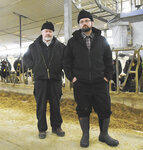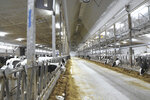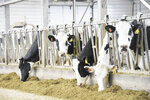


How many times a day do you milk, and what is your current herd average, butterfat and protein? We use a robotic milking system and average 2.7 visits per cow per day. We are producing 30,476 pounds of milk with 1,327 pounds of fat and 1,017 pounds of protein.
Describe your housing and milking facility. We house the cows in a 6-row freestall facility retrofitted with DeLaval robots. The barn has cross ventilation for the summer and natural/power ventilation during the winter.
Who is part of your farm team, and what are their roles? John Jr. and John L. feed all groups of cattle. Joel and Isaiah manage calves and youngstock. Brian does a lot of the genetics and herd work. Michael is the maintenance manager on the robots, and Jesse assists with health and herd work.
What is your herd health program? Ultrasound pregnancy checks are performed every two weeks with Dr. Sletten, and our vaccination protocol is set up with his recommendation. Fresh cows get Inforce at freshening; Pyramid 10 and Endovac Dairy at 20-30 days in milk; Endovac at 150 DIM, a vaccine for leptospirosis at 150 days carried calf; and Endovac Dairy and Vision 8 at dry off.
What does your dry cow and transition program consist of? We use a 60-day dry period. Dry cows are housed in an open-sided pack barn. Three weeks before calving, cows are brought back to the main barn into free stalls where they are watched closely for calving and then moved to a calving pen when actively calving. Fresh cows have their udder clipped, are vaccinated and moved to a robot pen where they remain for the entire lactation.
What is the composition of your ration, and how has that changed in recent years? Our ration consists of corn silage, haylage, dry hay, cottonseed and a grain/mineral mix. We maximize forage content to the top level cows and work closely with our nutritionist, Dan Schimek, from NutriQuest on our ration formulation.
Tell us about the forages you plant and detail your harvest strategies. We plant brown mid-rib corn silage as it’s second to none in digestive fiber. A high-stress growing season does have a larger impact on yields, though. We start to harvest when it hits 30% dry matter, expecting an average across the pile of 32%-35% DM when finished. Alfalfa hay is chopped on first cutting and baled and wrapped on the subsequent cuttings. John believes in balage you can put through the hay buster, so it is usually between 25%-30% moisture.
What is your average somatic cell count and how does that affect your production? Our average SCC is usually around 180,000, but will increase in the hotter months of the year.
What change has created the biggest improvement in your herd average? There’s hardly ever a single change that can drastically improve a herd, right? We credit genetics as laying the base foundation and makeup of the cattle and then having them in an environment where they can perform to their top genetic potential. That includes calves starting at 1 day of age. Feed, of course, has a major impact in performance as that’s the fuel that drives the engine. The better your forage quality, the more milk you can squeeze out of a pound of feed.
What technology do you use to monitor your herd? We use CowManager tags to monitor the herd for heats and sick cows. We’ve been happy with the performance of the system, and they’re always making it more inclusive and upgrading the platform.
What is your breeding program, and what role does genetics play in your production level? We are heavy into genetics. It has major impact on the performance of the herd. We routinely flush our top-genetic animals and have an extensive embryo transfer program where we use a large portion of the herd as recipients. The first implant is set up using a double ovsync, and we resync pre herd check and also watch for repeats using the CowManager tags.
List three management strategies that have helped you attain your production and component level. Genetics, environment, feed and ration formulation.
Tell us about your farm and your plans for the dairy in the next year. Blumenfeld Holsteins has milked cows at the current site since 1979. The original herd was 80 cows milked in a tiestall barn. We expanded to 120 cows in 1997 and added a parlor. We built the freestall/parlor to milk 300 cows in 2001. We expanded the barn and added robots in 2017. We always look for ways to economize and bring costs down without hindering performance. In the year ahead, we hope to capitalize on the more reasonably priced feedstuffs and continue our quest to build a better Holstein cow.
Comments
No comments on this item Please log in to comment by clicking here